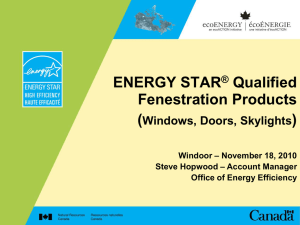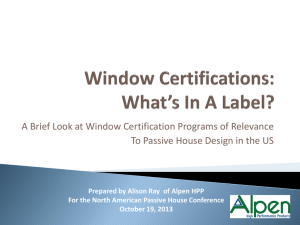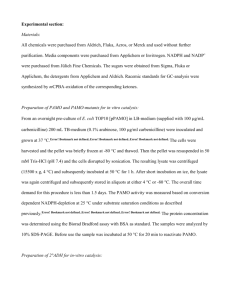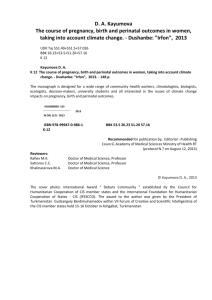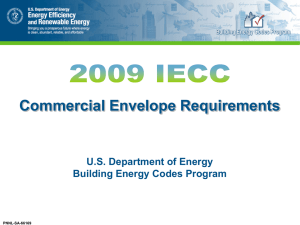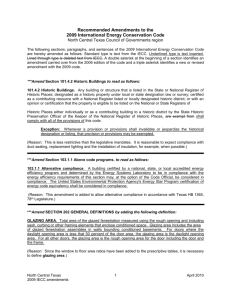NFRC 20X draft - NFRC Community
advertisement
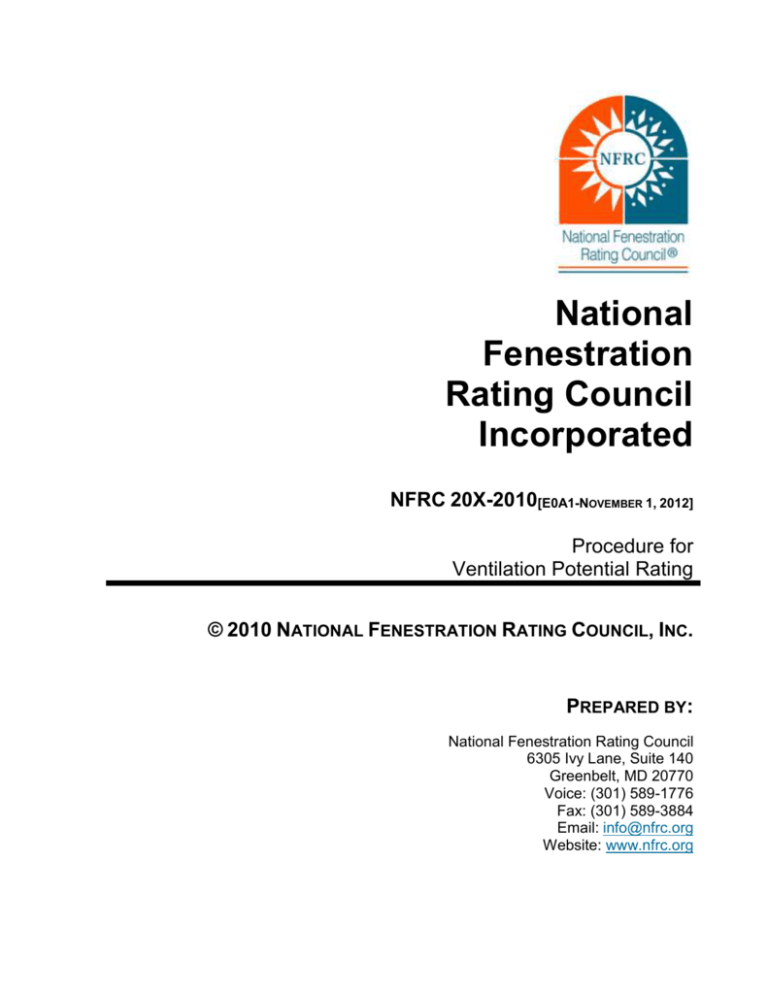
National Fenestration Rating Council Incorporated NFRC 20X-2010[E0A1-NOVEMBER 1, 2012] Procedure for Ventilation Potential Rating © 2010 NATIONAL FENESTRATION RATING COUNCIL, INC. PREPARED BY: National Fenestration Rating Council 6305 Ivy Lane, Suite 140 Greenbelt, MD 20770 Voice: (301) 589-1776 Fax: (301) 589-3884 Email: info@nfrc.org Website: www.nfrc.org FOREWORD The National Fenestration Rating Council, Incorporated (NFRC) has developed and operates a uniform rating system for energy and energy-related performance of fenestration products. The Rating System determines the U-factor, Solar Heat Gain Coefficient (SHGC) and Visible Transmittance (VT) of a product, which are mandatory ratings for labeling NFRC certified products, are mandatory ratings for inclusion on label certificates, and are supplemented by procedures for voluntary ratings of products for Air Leakage (AL), and Condensation Resistance. Together, these rating procedures, as set forth in documents published by NFRC, are known as the NFRC Rating System. The NFRC Rating System employs computer simulation and physical testing by NFRCaccredited laboratories to establish energy and related performance ratings for fenestration product types. The NFRC Rating System is reinforced by a certification program under which NFRC-licensed responsible parties claiming NFRC product certification shall label and certify fenestration products to indicate those energy and related performance ratings, provided the ratings are authorized for certification by an NFRC-licensed certification and Inspection Agency (IA). The requirements of the rating, certification, and labeling program (Certification Program) are set forth in the most recent versions of the following as amended, updated, or interpreted from time to time: NFRC 700 Product Certification Program (PCP). NFRC 705 Component Modeling Approach (CMA), Product Certification Program (CMA-PCP). Through the Certification Program and the most recent versions of its companion programs as amended, updated, or interpreted from time to time: The laboratory accreditation program (Accreditation Program), as set forth in the NFRC 701 Laboratory Accreditation Program (LAP). The IA licensing program (IA Program), as set forth in NFRC 702 Certification Agency Program (CAP). The CMA Approved Calculation Entity (ACE) licensing program (ACE Program), as set forth in the NFRC 708 Calculation Entity Approval Program (CEAP). NFRC intends to ensure the integrity and uniformity of NFRC ratings, certification, and labeling by ensuring that responsible parties, testing and simulation laboratories, and IAs NFRC 200-2010[E0A1] page ii adhere to strict NFRC requirements. In order to participate in the Certification Program, a Manufacturer/Responsible Party shall rate a product whose energy and energy-related performance characteristics are to be certified in accordance with mandatory NFRC rating procedures. At present, a Manufacturer/Responsible Party may elect to rate products for U-factor, SHGC, VT, AL, Condensation Resistance, or any other procedure adopted by NFRC, and to include those ratings on the NFRC temporary label affixed to its products, or on the NFRC Label Certificate. U-factor, SHGC and VT, AL, and Condensation Resistance rating reports shall be obtained from a laboratory that has been accredited by NFRC in accordance with the requirements of the NFRC 701. The rating shall then be reviewed by an IA which has been licensed by NFRC in accordance with the requirements of the NFRC 702. NFRC-licensed IAs also review label format and content, conduct in-plant inspections for quality assurance in accordance with the requirements of the NFRC 702, and issue a product Certification Authorization Report (CAR), or approve for issuance an NFRC Label Certificate for site-built or CMA products and attachment products. The IA is also responsible for the investigation of potential violations (prohibited activities) as set forth in the NFRC 707 Compliance and Monitoring Program (CAMP). Ratings for products that are labeled with the NFRC Temporary and Permanent Label, or products that are listed on an NFRC Label Certificate in accordance with NFRC requirements, are considered to be NFRC-certified. NFRC maintains a Certified Products Directory (CPD), listing product lines and individual products selected by the manufacturer/responsible party for which certification authorization has been granted. NFRC manages the Rating System and regulates the Product Certification Program (PCP), Laboratory Accreditation Program (LAP) and Certification Agency Program (CAP) in accordance with the NFRC 700 (PCP), the NFRC 701 (LAP), the NFRC 702 (CAP), the NFRC 705 (CMA-PCP), and the NFRC 708 (CEAP) procedures, and conducts compliance activities under all these programs as well as the NFRC 707 (CAMP). NFRC continues to develop the Rating System and each of the programs. NFRC owns all rights in and to each of the NFRC 700, NFRC 701, NFRC 702, NFRC 705, NFRC 707, NFRC 708 and each procedure, which is a component of the Rating System, as well as each of its registration marks, trade names, and other intellectual property. The structure of the NFRC program and relationships among participants are shown in Figure 1, Figure 2, and Figure 3. For additional information on the roles of the IAs and laboratories and operation of the IA Program and Accreditation Program, see the NFRC 700 (PCP), NFRC 701 (LAP), and NFRC 702 (CAP) respectively. NFRC 200-2010[E0A1] page iii Figure 1 Figure 2 NFRC 200-2010[E0A1] page iv Figure 3 Questions on the use of this procedure should be addressed to: National Fenestration Rating Council 6305 Ivy Lane, Suite 140 Greenbelt, MD 20770 Voice: (301) 589-1776 Fax: (301) 589-3884 Email: info@nfrc.org Website: www.nfrc.org NFRC 200-2010[E0A1] page v DISCLAIMER NFRC certification is the authorized act of a Manufacturer/Responsible Party in: (a) labeling a fenestration or related attachment product with an NFRC Permanent Label and NFRC Temporary Label, or (b) generating a site built or CMA label certificate, either of which bears one or more energy performance ratings reported by NFRC-accredited simulation and testing laboratories and authorized for certification by an NFRC-licensed IA. Each of these participants acts independently to report, authorize certification, and certify the energy-related ratings of fenestration and related attachment products. NFRC does not certify a product and certification does not constitute a warranty of NFRC regarding any characteristic of a fenestration or fenestration-related attachment product. Certification is not an endorsement of or recommendation for any product or product line or any attribute of a product or product line. NFRC is not a merchant in the business of selling fenestration products or fenestration-related products, and therefore cannot warrant products as to their merchantability or fitness for a particular use. NFRC THEREFORE DISCLAIMS ANY AND ALL LIABILITY THAT MAY ARISE FROM OR IN CONNECTION WITH SERVICES PROVIDED BY, DECISIONS MADE BY OR REPORTS OR CERTIFICATIONS ISSUED OR GRANTED BY ANY NFRC-ACCREDITED LABORATORY, NFRC-LICENSED IA OR ANY PRODUCT MANUFACTURER/ RESPONSIBLE PARTY; RELIANCE ON ANY NFRC PRODUCT DESCRIPTION, SPECIFICATION, RATING, TEST OR CERTIFICATION, WHETHER APPEARING IN A REPORT, A PRODUCT CERTIFICATION AUTHORIZATION OR A PRINTED OR ELECTRONIC DIRECTORY, OR ON A LABEL, OR ON A LABEL CERTIFICATE; OR THE SALE OR USE OF ANY NFRC-RATED OR CERTIFIED PRODUCT OR PRODUCT LINE; INCLUDING BUT NOT LIMITED TO DAMAGES FOR PERSONAL OR OTHER INJURY, LOST PROFITS, LOST SAVINGS OR OTHER CONSEQUENTIAL OR INCIDENTAL DAMAGES. NFRC program participants are required to indemnify NFRC from and against such liability. NFRC 200-2010[E0A1] page vi Table of Contents Foreword............................................................................................................................. ii Disclaimer ...........................................................................................................................vi Table of Contents ..............................................................................................................vii 1. Purpose ................................................................................................................... 2 2. Scope....................................................................................................................... 2 2.1 2.2 PRODUCTS AND EFFECTS COVERED ................................................................ 2 2.1.1 Products Covered Using NFRC 201 Test Procedure for SHGC .. Error! Bookmark not defined. PRODUCTS AND EFFECTS NOT COVERED ......................................................... 3 2.2.1 Products and Effects Not Covered (SHGC) ...................................... 3 2.2.2 Products and Effects Not Covered (VT) ............................................. 3 3. Definitions ............................................................................................................... 3 4. General .................................................................................................................... 5 4.1 4.2 4.3 4.4 4.5 COMPLIANCE .................................................ERROR! BOOKMARK NOT DEFINED. 4.1.1 Product Line Simulation and Testing ................................................. 5 4.1.2 Testing Alternative .............................. Error! Bookmark not defined. PRODUCT LINES AND INDIVIDUAL PRODUCTS .................................................... 5 4.2.1 Product Lines .................................................................................... 5 4.2.2 Individual Products ............................................................................ 5 4.2.3 Grouping of Products ......................................................................... 5 STANDARD CONDITIONS .................................ERROR! BOOKMARK NOT DEFINED. 4.3.1 Simulation........................................... Error! Bookmark not defined. 4.3.2 Testing ............................................... Error! Bookmark not defined. 4.3.3 Environmental Conditions during NFRC 201 Testing Error! Bookmark not defined. 4.3.3.1 Center-of-Glazing Component Test Procedure ............... Error! Bookmark not defined. MODEL SIZES AND CONFIGURATIONS ..............ERROR! BOOKMARK NOT DEFINED. SIMULATION PROCEDURES .............................................................................. 5 Table 4-1 Representative Glazing Pane Thicknesses .. Error! Bookmark not defined. 4.5.1 Component ......................................... Error! Bookmark not defined. NFRC 200-2010[E0A1] page vii 4.6 4.7 5. 4.5.1.1 Approved Center-of-Glazing Simulation Program ............ Error! Bookmark not defined. 4.5.1.2 Approved 2-D Heat Transfer Simulation Program ........... Error! Bookmark not defined. TEST PROCEDURES .......................................ERROR! BOOKMARK NOT DEFINED. 4.6.1 Total Fenestration Product.................. Error! Bookmark not defined. 4.6.2 Component ......................................... Error! Bookmark not defined. TOTAL FENESTRATION PRODUCT RATING ........ERROR! BOOKMARK NOT DEFINED. Variation from the General Requirements ................. Error! Bookmark not defined. 5.1 5.2 5.3 5.4 5.5 5.6 5.7 WINDOW AND SLIDING GLASS DOORS .............ERROR! BOOKMARK NOT DEFINED. SWINGING DOORS .........................................ERROR! BOOKMARK NOT DEFINED. 5.2.1 Calculation of Total Product Rating..... Error! Bookmark not defined. 5.2.1.1 Simplification ........................... Error! Bookmark not defined. SKYLIGHTS ....................................................ERROR! BOOKMARK NOT DEFINED. TUBULAR DAYLIGHTING DEVICES ....................ERROR! BOOKMARK NOT DEFINED. GARAGE (VEHICULAR ACCESS) DOORS ...........ERROR! BOOKMARK NOT DEFINED. SITE BUILT ....................................................ERROR! BOOKMARK NOT DEFINED. APPLIED FILMS ..............................................ERROR! BOOKMARK NOT DEFINED. 5.7.1 Scope ................................................ Error! Bookmark not defined. 5.7.2 Variations from Standard Product Lines............. Error! Bookmark not defined. 5.7.3 Variations from Standard Individual Products .... Error! Bookmark not defined. 5.7.4 Variations from Standard Simulation and Test Conditions .......... Error! Bookmark not defined. 5.7.4.1 Approved Center-of-Glazing Computational Program ..... Error! Bookmark not defined. Table 5-1 Center-of-Glazing Values -- SHGCc and VTc Error! Bookmark not defined. 5.7.5 Calculation of Total Product Rating..... Error! Bookmark not defined. Table 5-2 Values of SHGC0 and SHGC1 and VT0 and VT1 for Reference Products ............................................. Error! Bookmark not defined. 5.7.5.1 Reference Fenestration Products ........... Error! Bookmark not defined. Table 5-3 Values of SHGC and VT for Reference Fenestration Products and Applied Film ........................................ Error! Bookmark not defined. 5.7.5.2 Total Fenestration Product SHGC .......... Error! Bookmark not defined. 5.7.5.3 Total Fenestration Product VT Error! Bookmark not defined. 5.7.6 Testing ............................................... Error! Bookmark not defined. 5.7.6.1 Center-of-Glazing Component Test Procedure ............... Error! Bookmark not defined. 5.7.6.2 Total Fenestration Product Test Procedure .. Error! Bookmark not defined. 5.7.6.3 Total Fenestration Product SHGC for Non-Model Sizes .. Error! Bookmark not defined. 5.7.7 Figures ............................................... Error! Bookmark not defined. Figure 5-1 Residential Fixed Aluminum Frame Reference Product ....... Error! Bookmark not defined. Figure 5-3 Cross Section A ........................... Error! Bookmark not defined. NFRC 200-2010[E0A1] page viii 5.8 5.9 6. Figure 5-4 Cross Section B ........................... Error! Bookmark not defined. DYNAMIC ATTACHMENT PRODUCTS FOR SWINGING DOORS ... ERROR! BOOKMARK NOT DEFINED. 5.8.1 Scope ................................................ Error! Bookmark not defined. 5.8.2 Methodology ....................................... Error! Bookmark not defined. 5.8.3 Approved Computational Program ...... Error! Bookmark not defined. COMPONENT MODELING APPROACH (CMA) FOR NON-RESIDENTIAL BUILDING FENESTRATION PRODUCTS.............................ERROR! BOOKMARK NOT DEFINED. 5.9.1 Scope ................................................ Error! Bookmark not defined. 5.9.2 Variations from Standard Product Lines............. Error! Bookmark not defined. 5.9.3 Variations from Standard Individual Products .... Error! Bookmark not defined. 5.9.4 Variations from Standard Simulation and Test Conditions .......... Error! Bookmark not defined. 5.9.4.1 Simplifications to a Product Line – Frame Components .. Error! Bookmark not defined. 5.9.5 Calculation of Total Product Rating..... Error! Bookmark not defined. 5.9.5.1 Component Modeling Procedure ............ Error! Bookmark not defined. 5.9.5.2 Basic Product Line Model and Component Information for Calculating and Reporting SHGC and VT .... Error! Bookmark not defined. 5.9.5.3 Definition of Low and High Configurations .... Error! Bookmark not defined. 5.9.5.4 Approved Total Fenestration Product SHGC Calculation Procedure ........................... Error! Bookmark not defined. 5.9.5.5 Determining SHGC and VT for Sloped Glazing Systems. Error! Bookmark not defined. 5.9.5.6 Approved Total Fenestration Product SHGC and VT for NonModel Sizes ........................... Error! Bookmark not defined. References .............................................................................................................. 9 Appendix A (Non-Mandatory Information) ........................................................11 Index ...................................................................................... Error! Bookmark not defined. NFRC 200-2010[E0A1] page ix 1. PURPOSE To specify a method for calculating solar heat gain coefficient (SHGC) and visible transmittance (VT) at normal (perpendicular) incidence for fenestration products containing glazings or glazing with applied films, with specular optical properties calculated in accordance with ISO 15099 (except where noted) or tested in accordance with NFRC 201. [Note: This standard specifies a method for calculating the solar heat gain and visible transmittance from direct solar radiation through most fenestration products at normal incidence only. This procedure is limited to normal incidence calculations because solar optical data needed for such calculations is typically only available at normal incidence. While solar radiation rarely enters a fenestration product at normal incidence, SHGC and VT at near normal angles of incidence (less than 30o off normal) are typically very similar to those at normal incidence; for other angles, the SHGC and VT at normal can be used, to first order, as an indicator of the relative magnitude of solar heat gain (SHG) and VT.] 2. SCOPE 2.1 To create a NFRC Ventilation rating system utilizing net clear opening less a screen factor. The process for developing the rating will be in three phases 2.1.1 Standardize the method for calculating fenestration net clear ventilation area dimensions, 2.1.2 Standardize the effect of screen mesh for two representative screen cloth categories 2.1.3 Develop a rating system for NFRC certification purposes based on current standardized sizes 2.2 2.3 Products and Effects Covered A. Products of all operable unit types including (but not limited to) vertical sliding windows, horizontal sliding windows, casement windows, projecting windows, non-standard shaped windows, glazed wall systems, bay or bow windows, skylights, and access doors (with or without glazed areas); B. Single or multiple assemblies of exterior doors; C. Products of any size; D. Products designed for installation at any tilt. NFRC 200-2010[E1A0] page 2 2.4 Products and Effects Not Covered 2.4.1 Products and Effects Not Covered All non-operable, fixed products, and tubular daylighting devices. 3. DEFINITIONS Definitions and terms are in accordance with definitions in NFRC 100; terms not specified in NFRC 100 have been selected to apply to the fenestration systems. Fenestration product with attachment: the total fenestration product resulting when a fenestration attachment is combined with (i.e., installed on) a reference fenestration product in the manner recommended by the manufacturer. Fenestration attachment: a device designed to be physically attached to, incorporated with or covering a product that has been or may be rated according to NFRC procedures. Film: fenestration attachment products which consist of a flexible adhesive-backed polymer film which may be applied to the interior or exterior surface of an existing glazing system. Interlayer: a layer of material acting as an adhesive between plies of glass which adds additional performance to the finished product, for example, impact resistance, solar control, acoustical insulation. Laminated glass: an assembly consisting of two or more lites of glass (conforming to ASTM Standard C 1036 or C 1048), that are bonded together by interlayer material. Lite: another term for a pane of glass used in a fenestration product. (Frequently spelled 'lite' in industry literature to avoid confusion with “light,” as in visible light.) Reference fenestration product: the fenestration product that an attachment is combined with for the purposes of rating. A reference fenestration product comprises a reference glazing system and a reference frame with a specified construction. Reference glazing system: the glazing system in the reference fenestration product. Reference frame: the frame of the reference fenestration product. This may or may not correspond to an actual frame type available commercially. The reference frames used for this procedure are shown in Section 5.7. Solar Heat Gain Coefficient (SHGC): Solar Heat Gain Coefficient (SHGC): the ratio of the solar heat gain entering the space through the fenestration product to the incident solar radiation. Solar heat gain includes directly transmitted solar heat and that portion of the absorbed solar radiation which is then reradiated, conducted, or convected into the space. Frame Solar Heat Gain Coefficient (SHGCf): the solar heat gain through all frame and sash members divided by the total incident solar radiation and the frame area, as defined in NFRC 100. NFRC 200-2010[E1A0] page 3 Divider Solar Heat Gain Coefficient (SHGCd): the SHGC representative of the divider area, as defined in NFRC 100. Edge-of-glazing Solar Heat Gain Coefficient (SHGCe): the SHGC representative of the edge-of-glazing area, as defined in NFRC 100. Edge-of-divider Solar Heat Gain Coefficient (SHGCde): the SHGC representative of the edge-of-divider area, as defined in NFRC 100. Center-of-glazing Solar Heat Gain Coefficient (SHGCc): the SHGC representative of the center-of-glazing area, as defined in NFRC 100. Total fenestration product Solar Heat Gain Coefficient (SHGCt): the SHGC representative of the total fenestration product, as defined in Equation 4-3 of Section 4.7. SHGC0: the total fenestration product SHGC for a center-of-glazing SHGC of 0.0. SHGC1: the total fenestration product SHGC for a center-of-glazing SHGC of 1.0. Frame absorptance: the fraction of solar radiation absorbed by the exterior frame surface. Frame color: the color of the exterior frame surface exposed to solar radiation (see frame absorptance). Visible Transmittance (VT): Visible Transmittance (VT): the ratio of the visible light entering the space through the fenestration product to the incident visible light. The visible light entering a space is weighted by the photopic response of the eye (refer to NFRC 300). Frame Visible Transmittance (VT f): the visible light through all frame and sash members divided by the total incident visible light and the frame area (as defined in NFRC 100). Divider Visible Transmittance (VTd): the VT representative of the divider area, as defined in NFRC 100. Edge-of-glazing Visible Transmittance (VTe): the VT representative of the edge-of-glazing area, as defined in Section 4.6 of NFRC 100; the value equals the center-of-glazing VT. Edge-of-divider Visible Transmittance (VTde): the VT representative of the edge-of-divider area, as defined in NFRC 100; the value equals the center-ofglazing VT. Center-of-glazing Visible Transmittance (VTc): the VT representative of the center-of-glazing area, as defined in NFRC 100. Total fenestration product Visible Transmittance (VTt): the VT representative of the total fenestration product, as defined in Equation 4-4 of Section 4.7. VTo: the total fenestration product VT for a center-of-glazing VT of 0.0. VT1: the total fenestration product VT for a center-of-glazing VT of 1.0. NFRC 200-2010[E1A0] page 4 4. GENERAL 4.1 Total Fenestration Product Ventilation Area (VA) Ratings Total fenestration product Ventilation Area (VA) ratings shall be determined following the procedure outlined in Section 4.4Product Line Simulation VA ratings shall be calculated for operable products using the fenestration product model sizes as given in Table 4-3 of NFRC 100. Fenestration products shall be evaluated at their maximum design opening dimension. Fenestration products shall be evaluated with screens and no other applied devices. 4.2 Product Lines and Individual Products 4.2.1 Product Lines Refer to Section 4.2.1 of NFRC 100 for the definition of a product line. 4.2.2 Individual Products Refer to Section 4.2.2 of NFRC 100 for the definition of an individual product, except that variations in glazing characteristics shall be permitted within an individual product. 4.2.3 Grouping of Products A. Grouping of individual products shall be permitted provided all individual products with the group have the same net clear opening. The Group Leader shall be the individual product within the group with the lowest VA rating as calculated in accordance with Section 4.3. All individual products within the group shall be assigned the VA rating associated with the Group Leader.B. Product groups shall be permitted to include products from multiple product lines provided the requirements of Section 4.2.3.A are met. 4.3 Ventilation Area Calculation Procedures NFRC 200-2010[E1A0] page 5 4.3.1. For all sliding products, the Ventilation Area (VA) shall be the gray shaded area in Figure 1 below, calculated as follows: VA = VOH • VOW • appropriate screen cloth reduction factor If the screen frame encroaches into the opening, as indicated in red in Figure 1, VOH and VOW shall be reduced accordingly Ventilation Opening Height at Maximum Design Opening (VOH) Screen Frame Encroachment Ventilation Opening Width (VOW) Figure 1 NFRC 200-2010[E1A0] page 6 4.3.2 For all projecting products where the maximum design opening dimension is less than 30, the Ventilation Area (VA) shall be calculated as follows: VA1 = VOH • VOW • appropriate screen cloth reduction factor o If the screen frame encroaches into the opening, as indicated in red in Figure 2, VOH and VOW shall be reduced accordingly VA2 = PD • (SH + SW) VA = the lesser of VA1 and VA2 Area resulting from the sash “drop” is not included in the Ventilation Area calculation Sash Height (SH) Projected Distance at Maximum Design Opening (PD) NFRC 200-2010[E1A0] Ventilation Opening Height (VOH) Ventilation Opening Width (VOW) Less than 30 Screen Frame Encroachment Sash Width (SW) Figure 2 page 7 4.3.3 For all projecting products where the maximum design opening dimension is 30 or greater, the Ventilation Area (VA) shall be the gray shaded area in Figure 3 below, calculated as follows, assuming that the sash is opened 90: VA = VOH • (VOW – SD) • appropriate screen cloth reduction factor The Sash Depth reduction shall apply only if the open sash is within the VOW rectangle If the screen frame encroaches into the opening, as indicated in red in Figure 3, VOH and VOW shall be reduced accordingly Ventilation Opening Width (VOW) Ventilation Opening Height (VOH) Screen Frame Encroachment Sash Depth (SD) Figure 3 4.3.4 For dual-action products, such as tilt-turn windows or doors, the Ventilation Area (VA) shall be calculated and reported based on the mode of operation that yields the greatest Ventilation Area. 4.3.4.1 Optionally, at the manufacturer’s discretion, the Ventilation Area (VA) may also be calculated and reported based on both modes of operation. NFRC 200-2010[E1A0] page 8 5. [section 4. [section 4. [section 5. 4.3.2.4] [section 6. add screen assembly information] add screen cloth information] Simulation data and informational needs, expand on NFRC 700 section Screen drawings] REFERENCES 1) NFRC 100-2010: Procedure for Determining Fenestration Product U-factors. National Fenestration Rating Council: Greenbelt, MD; 2010. www.nfrc.org. 2) NFRC 300-2010: Test Method for Determining the Solar Optical Properties of Glazing Materials and Systems. National Fenestration Rating Council: Greenbelt, MD; 2010. www.nfrc.org. 3) NFRC Simulation Manual. National Fenestration Rating Council: Greenbelt, MD. www.nfrc.org. 4) List of Approved Simulation Computer Programs. National Fenestration Rating Council: Greenbelt, MD. www.nfrc.org. 5) ISO/FDIS 15099. Thermal Performance of Windows, Doors and Shading Device-– Detailed Calculations. International Organization for Standardization: Geneva, Switzerland. www.iso.org 6) ASTM Standard C 1172. “Standard Specification for Laminated Architectural Flat Glass.” ASTM International, West Conshohocken, PA, 2009, DOI: 10.1520/C1172-09, www.astm.org. 7) ASTM Standard C 1036. “Standard Specification for Flat Glass,” ASTM International, West Conshokocken, PA, 2006, DOI: 10.1520/C1036-06, www.astm.org. NFRC 200-2010[E1A0] page 9 8) ASTM Standard C 1048. “Standard Specification for Heat-Treated Flat Glass—Kind HS, Kind FT Coated and Uncoated Glass.” ASTM International, West Conshohocken, PA, 2004, DOI: 10.1520/C1048-04, www.astm.org. 9) CIE “Colorimetry Technical Report.” 15:2004 (3rd Edition). International Commission on Illumination (CIE), Vienna, Austria. www.cie.co.at. 10) Curcija DC, Bhandari MS, Manteghi M, Shah BV. “Component Modeling Methodology for Predicting Thermal Performance of Non-Residential Fenestration Systems,” Thermal Performance of Building Envelopes IX, Clearwater, FL. December, 2004. NFRC 200-2010[E1A0] page 10 APPENDIX A (NON-MANDATORY INFORMATION) Determination of VA Ratings at Non-Standard Sizes The approved total fenestration product VA rating calculation procedure may be used to calculate total fenestration product VA ratings for sizes other than the Model Sizes defined in Table 4-3 of NFRC 100. Such VA ratings shall be calculated only for those product lines and individual products of a product line that have been submitted to an NFRC-licensed independent certification and Inspection Agency (IA) for certification authorization purposes at the Model Sizes defined in Table 4-3 of NFRC 100. VA ratings that are calculated for sizes other than the Model Sizes in Table 43 of NFRC 100 are for informational purposes only and shall not be used for purposes of certification and labeling. NFRC 200-2010[E1A0] page 11
